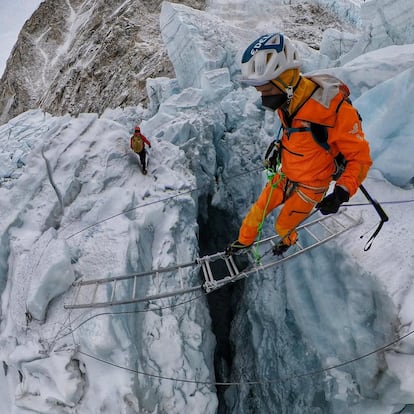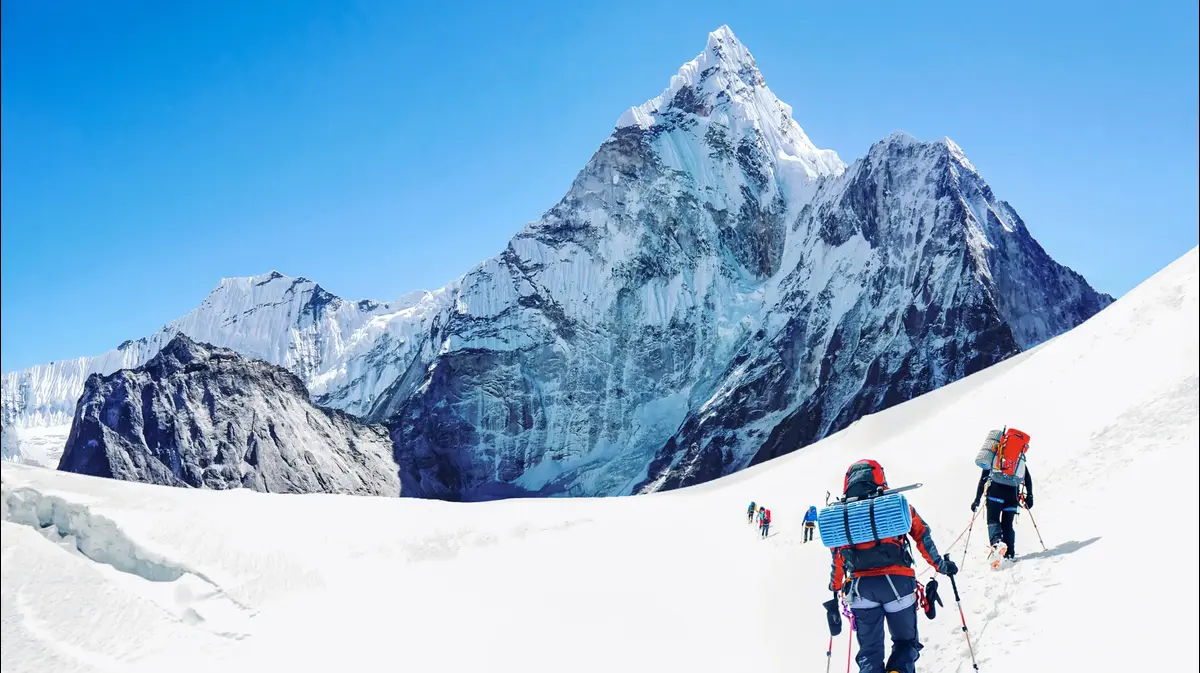An icon of consumerism turned into a mountain, Everest has lost its magical aura to embrace selfie tourism and pomp on social networks.
Even so, reaching the so-called roof of the planet by one of its two normal routes without using artificial oxygen remains a very serious challenge even for professional climbers, a physiological challenge of the first order.
Doing it this clean way via a different route, which requires real climbing, is almost inhumane.
There have been 10,700 ascents since 1953, the year in which the New Zealand beekeeper Edmund Hillary and the Nepalese Sherpa Tenzing Norgay stepped on the coveted peak for the first time.
Both carried cylinders connected to a mask on their backs that allowed them to breathe bottled oxygen to compensate for the drop in atmospheric pressure.
Since then,
In the 1960s, scientific studies determined that on the roof of the planet, human beings could only survive in a resting position, without walking or doing anything other than breathing to stay alive, and that is if their brains did not suffer irreparable damage due to the lower supply of oxygen.
In 1978, the South Tyrolean Reinhold Messner and the Austrian Peter Habeler contradicted scientific predictions and sneaked to the top of Everest without using artificial oxygen.
Habeler was so afraid of medical instructions that in the high altitude camps he could not sleep even by stuffing himself with sleeping pills.
The physical effort to reach his goal was so enormous that they reached the top by literally crawling.
Messner is considered to be the best mountaineer in history and Habeler was an elite Himalayan climber.
The example of him
More information
This is how the human body turns off on the way to the top of Everest: "It is an environment in which you can hardly survive"
German mountain guide and professional alpinist David Goettler scaled Everest last spring without using bottled oxygen using the original route from Nepal.
He was spending his fifth summit permit for three trips.
In 2021, he tried it with Kilian Jornet, but the heat left them melted on the key day.
In 2019, the year of the viral queues on the roof of the planet, of the dead waiting for a place at the top, he decided to leave: there was no way to break through the crowd.
Goettler resides on horseback between Cantabria and Chamonix and, a few days after his return from Nepal, he appears still consumed by the effort: "I lost about six kilos (I weighed 66 kg for 1.75 m at the beginning of the expedition) and when I returned I couldn't stop to sleep”, he recounts laughing.
00:47
David Goettler reaching the top of Everest
Arrival at the top of Everest by David Goettler.
To measure up to Everest without oxygen, Goettler needed a day of high pressures and rather warm weather, but he had low pressures and suffered temperatures of 30 degrees below zero.
He needed weak winds and he had them.
He needed as little traffic as possible, and when the waves to the top followed one another, he waited a bit and launched his attack: he was alone at the top and barely passed half a dozen challengers on his final run.
He needed to be in shape and he has been that way for years, trained by one of the best specialists, running around 100 kilometers a week in the mountains, skiing, climbing... He needed to be light and, hand in hand with his sponsors, he designed versatile garments and minimalist accessories looking for absolute efficiency: no one would help him get his gear up and down, no Sherpa would set up his tent, melt the snow for him,
I wouldn't take care of him.
She was going to be alone even if she had the misfortune to coincide with 50 more on summit day.
The one that circulates without oxygen is a bird as rare as it is apparently weak, and in the event of a mishap, it is normal to die right there.
For all this, finally, he was going to need to be autonomous, a quality that almost nobody observes on Everest and he was going to need his body not to betray him.
“I reached pitch 4 in the afternoon and focused on setting up the tent and recovering, hydrating as much as possible.
At nine o'clock at night, lacking a jacket, I realized that I was losing a lot of energy trying to keep warm, and I saw that the intensity of the wind had dropped a lot.
So, at 9:30 I started walking”, recalls Goettler.
950 meters of unevenness separated him from the top.
The best known time in a vertical kilometer of mountain is owned by Kilian Jornet: 28 minutes and 47 seconds for 977 positive meters in 1.77 kilometers.
The distance between Camp 4 and the top of Everest on its southern slope is, according to David Goettler's GPS watch, 1.60 kilometres, although on the topographic map consulted by the latter it would be 2 kilometres.
Figures similar to those of Jornet's vertical kilometer, achieved below the 1,800 meter mark.
Goettler spent 12 hours and 20 minutes reaching the top of the planet.
Six long hours to return to his tent in camp 4. These are tremendous figures that speak of "agony, something distressing", recalls the German mountaineer.
Shortly after reaching 8,500 meters, his performance began to plummet.
He began the suffering: the intensity of the wind grew,
moving the snow and partially covering the footprint: “It was barely one or two centimeters, but it made me slip and that increased my effort.
So, I took a step, I breathed four times like a locomotive, I took another step, I breathed four times… like that for hours.
National Geographic installed a meteorological station at 8,810 meters on May 9, whose information is precious for expeditions and for the study of climate change, and they had assured me that the top was next to it.
I don't know how long it took to get there really...”.
National Geographic installed a meteorological station at 8,810 meters on May 9, whose information is precious for expeditions and for the study of climate change, and they had assured me that the top was next to it.
I don't know how long it took to get there really...”.
National Geographic installed a meteorological station at 8,810 meters on May 9, whose information is precious for expeditions and for the study of climate change, and they had assured me that the top was next to it.
I don't know how long it took to get there really...”.
David Goettler on Everest.David Goettler
Hours passed trying to stay alert, marking the key parts of the ascent and trying not to lose sight of the point of no return.
“I was very focused, mentally awake and attentive to any sign.
As I was alone, he talked to myself, reviewing my gestures, what I was missing, remembering that I had to go down... My arrival at the top was as lonely as it was funny.
I wanted to record the right moment so I gathered everything I had in my gut to take four unfortunate steps and make it seem like I was walking normally.
I had to throw myself on the ground when I finished”, he laughs now.
Obviously, “at the top I was happy that I didn't have to take another step up.
I was very focused on remembering that I had to get down as soon as possible without making mistakes and not celebrating anything too soon,” he notes.
Eighteen hours after leaving his store,
He returned to her, sat down and spent three more hours completing a task that at sea level would take him 30 minutes: “He told me that I had to melt snow, drink, collect my things, put them in my backpack… ten minutes passed and He hadn't moved a finger.
It was in slow motion."
She finally managed to descend to Camp 3 (7,300 meters) noticing how she improved the further she descended.
The next day she reached base camp.
She knows that she will never leave that summit.
300 meters) noticing how he improved the further he descended.
The next day he reached base camp.
He knows that he will never leave that summit.
300 meters) noticing how he improved the further he descended.
The next day he reached base camp.
He knows that he will never leave that summit.
David Goettler's equipment to reach the top of Everest
You can follow EL PAÍS Deportes on
and
, or sign up here to receive
our weekly newsletter
.
50% off
Exclusive content for subscribers
read without limits
subscribe
I'm already a subscriber














